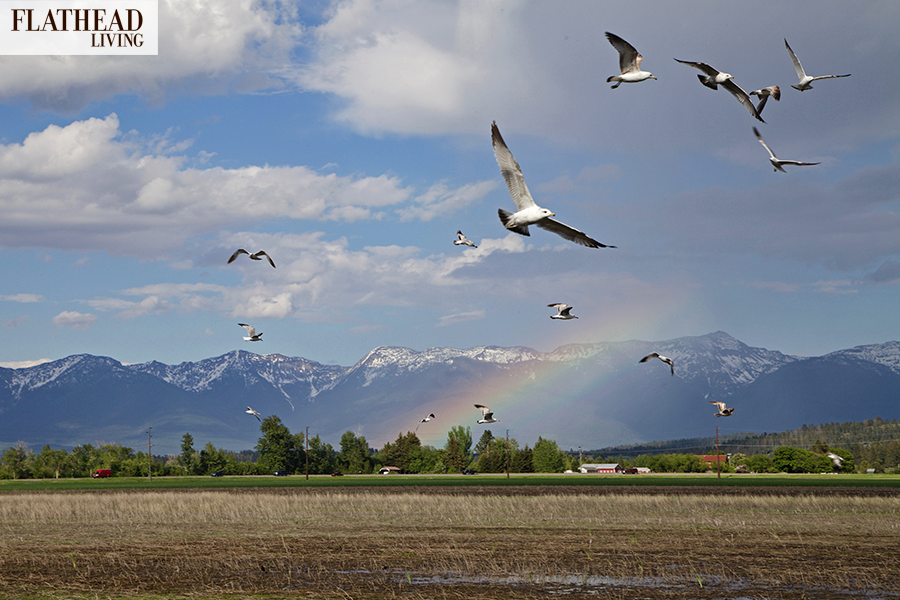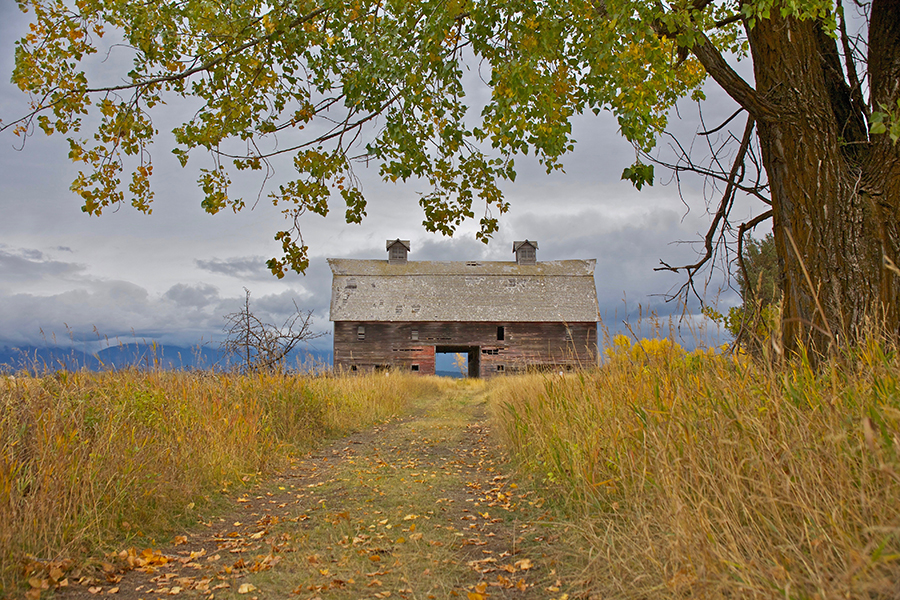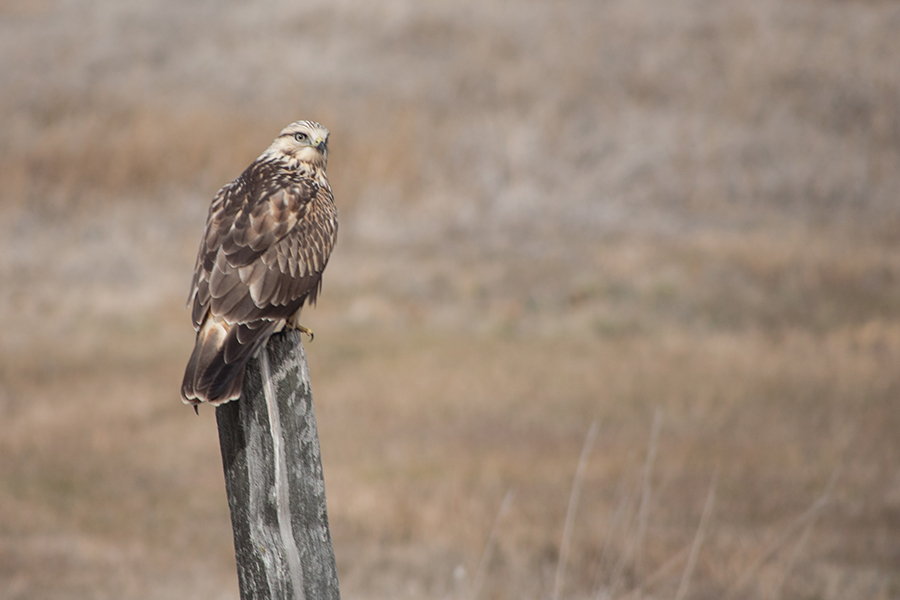Finding Refuge in Wild Places
The region’s wildlife refuges and waterfowl production areas are essential destinations for bird and animal watching, fishing, hunting and basking in gorgeous autumn scenery
By Kay Bjork
It’s early morning on the north shore of Flathead Lake — at least early in human terms, because much of the wildlife has been awake all night or up for hours. Ducks do their dizzy zigzag dance in search of food on a pond, while a whitetail deer and her fawn disappear into a veil of fog. Two eagles stand sentinel on the crooked branches of a gray snag, and a gigantic nest tops a cottonwood nearby. Flocks of ducks and swans bob in gentle waves on the quiet lake, and hundreds of gulls scatter, dotting the soft pastel of a morning sky.
Even thought the National Wildlife Refuge System (NWRS) was established to protect habitat and provide refuge for wildlife, these places also provide refuge for people seeking precious solitude in the beauty of wild places. Some areas such as the Waterfowl Production Area (WPA) are a component of the NWRS that also provide sportsmen and women a vibrant habitat for hunting and fishing, which helps balance the number of wildlife and fish with available food sources.
The NWRS began in 1903 when President Teddy Roosevelt signed an executive order that established Pelican Island in Florida as the first federal bird refuge, which became official under the Migratory Bid Conservation Act in 1929. Today there are more than 560 national wildlife refuges in the U.S. encompassing 850 million acres of land and ocean, home to more than 700 species of birds, 220 mammals, 250 reptiles and amphibians, thousands of fish, and numerous invertebrates and plants.
There are more than 200 nonprofit Refuge Friends organizations that support national wildlife refuges, while 42,000 volunteers donate time and ideas each year. Locally there have been school programs that contribute by mapping noxious weeds and vegetation, recording bird species and constructing footbridges on refuge trails.
It’s Mainly for the Birds
There are 20 different WPAs encompassing over 8,500 acres in the Northwest Montana Wetland Management District system, which is part of the National Bison Range Complex. The WPAs were established to preserve wetlands and grasslands critical to waterfowl and wildlife and to provide breeding and nesting habitat. Because of this, they are closed March 1–July 15 each year to limit disturbances to nesting birds.
WPAs were created in 1958 through an amendment to the Federal Duck Stamp Act with 98 cents of every dollar from the sales of federal duck stamps going directly to the purchase or lease of wetland habitat. Even though the majority of WPAs are located in the Prairie Pothole Region of North America, WPAs in northwest Montana are important for water-dependent birds. They are managed to maintain and enhance these areas for resident and migratory birds. Hunting is allowed on WPAs under federal and Montana state laws, which may vary at different WPAs.
There are five WPAs in Flathead County covering over 5,000 acres, which include the Flathead, Batavia, Blasdel, McGregor Meadows and Smith Lake production areas. Because they are especially important to migrating birds, fall and spring are a great time to visit these areas, which provide a wonderful resource for public use in a variety of ways, including wildlife observation, photography, birding, environmental education, hunting and fishing.
Blasdel WPA
Located five miles southeast of Kalispell, this 537-acre WPA is located near the magnificent historic Porter Ranch barn. Enjoy the backdrop of this handsome barn, but it’s off-limits because of safety issues. There is hope that funds will be found to restore the barn in the future. The oxbow channel contains water year-round, and seasonal ponds provide habitat for ducks, geese, pheasant and a variety of other wildlife.

Flathead WPA
Located on the north shore of Flathead Lake, this WPA includes seven miles of shoreline, upland and remnants of delta islands at the mouth of Flathead River.
The entire north shore of Flathead is also an Audubon-designated Important Bird Area (IPA) supporting a wide diversity of birds, including at least 229 species, with 172 of them regular, common or abundant seasonally, according to Audubon estimates. During the spring and fall migration, tens of thousands of waterfowl, including tundra swan, Canada geese, white pelicans, sandhill cranes, Northern pintail and American widgeon ducks, and as many as 5,000 gulls at a time roost in the area. The lake and shoreline provide a critical resting place for birds and waterfowl as they pass through the area during migration. The area also includes several bald eagle and osprey nest territories. Regulated by SKQ Dam, formerly Kerr Dam, the lower water levels in the fall create an expansive beach area for walking and exploring. Look for several signed access points along Montana Highway 82.
Batavia WPA
Upland, wetlands and marsh compose this WPA located five miles west of Kalispell on Ashley Creek, providing habitat for waterfowl that includes Canada geese and a variety of ducks. Walkers can enjoy observing and photographing wildlife while walking on the dike. The area also offers hunting and fishing opportunities.

Smith Lake WPA
Take U.S. Highway 2 west and turn left on Kila Road to reach the 923-acre WPA to view the abundant waterfowl and shorebirds found here during migration. You might also see mountain bluebirds. There is a boat launch for fishermen and hunters.
McGregor Meadows WPA
This area, 28 miles west of Kalispell and eight miles west of Marion, features a project to restore the natural stream flow of Notellum and Skookum Creeks and the wetland and riparian habitats that were altered by a series of drainage ditches. This restoration is aimed at supporting westslope cutthroat trout and other fish species and organisms.
Birds Rule(s)
Be aware that there are no facilities in these wild places, and visitors must park in designated areas only. A few more rules that help preserve the integrity of these areas are:
• No dogs off leash
• No off-road vehicles are allowed
• Collecting plants, animals, minerals, antlers and artifacts is prohibited

Two National Wildlife Refuges
Lost Trail National Wildlife Refuge
Located in the Pleasant Valley area of Flathead County, this refuge was established when Montana Power Company purchased a 3,100-acre ranch as part of a mitigation process and was then conveyed to the U.S Fish and Wildlife Service, which manages the property as Lost Trail NWR. Portions are open for hunting deer, elk, grouse and wild turkey.
Swan River National Wildlife Refuge
The Swan River National Wildlife Refuge was established in 1973 and recently expanded with the addition of the Swan River Oxbow area. The wetland was altered with drainage ditches excavated by early homesteaders and will be restored in the next few years. The goal is to restore wetlands and natural grasslands to improve habitat for waterfowl and improve water quality. The hope is that the restored wetland will bring back the area’s namesake swans.
Besides waterfowl and shorebirds, a variety of other wildlife can be found here, including black and grizzly bears, elk, moose, deer, coyotes, mountain lions, muskrats, and otters. The area is a key corridor between the Swan and Mission Mountains for grizzly bears.
Hunting is allowed on portions of the refuge, as shown on a map in the brochure or online at fws.gov/refuges. Fishing is permitted during waterfowl hunting season on the portion of Spring Creek north of Bog Road Trail.
Read more of our best long-form journalism in Flathead Living. Pick up the fall edition for free on newsstands across the valley.